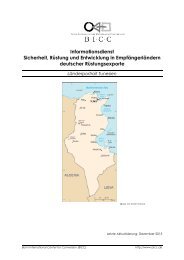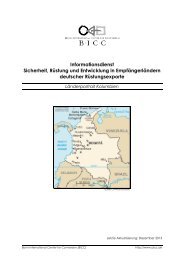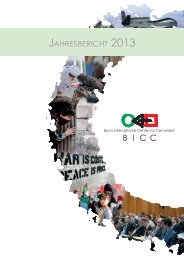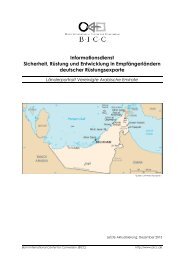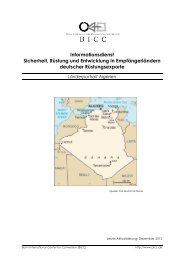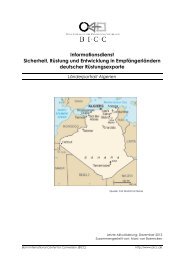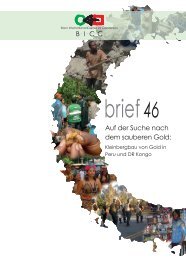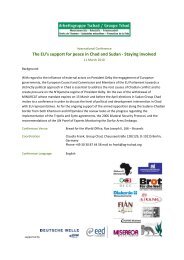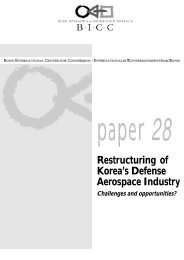English - BICC
English - BICC
English - BICC
Create successful ePaper yourself
Turn your PDF publications into a flip-book with our unique Google optimized e-Paper software.
ief 22<br />
The Twin Track<br />
Approach of<br />
the Agreement—<br />
“Fudging”<br />
the Arms<br />
Trying to reach a valid compromise<br />
in a peace agreement that can be<br />
sold as advantageous to all conflicting<br />
parties and their constituencies creates<br />
complex dilemmas, which have, not<br />
without deliberate euphemism, been<br />
described as “constructive ambiguities”<br />
(Guelke, 2000; Stevenson, 2000). This<br />
statement appears to be particularly<br />
appropriate when analysing the<br />
decommissioning debate in Northern<br />
Ireland since the 1994 peace talks.<br />
The Belfast Agreement, a settlement<br />
of an ethno-national conflict achieved<br />
after inclusive negotiations that<br />
endeavoured to incorporate the<br />
protagonists of an armed struggle, is<br />
considered to be one of the most<br />
comprehensive peace accords in the<br />
international arena, primarily due to its<br />
utilisation of a “twin track” approach.<br />
This approach encapsulates a specially<br />
designed strategy that facilitates the<br />
implementation of the political and<br />
security aspects of the settlement in<br />
two parallel corridors. While the<br />
constitutional provisions of the accord,<br />
its consociational and confederal<br />
devices (Brendan O’Leary, in Wilford,<br />
ed., 2001, pp. 49–83), seemed to offer a<br />
firm and unequivocal road to solve the<br />
political dispute over the province’s<br />
future, the devices dealing with the<br />
vital security issues of disarmament<br />
and demilitarisation were phrased in an<br />
intentionally vague fashion,<br />
highlighting the emerging reality that<br />
decommissioning would only be solved<br />
“… in the context of the<br />
implementation of the overall<br />
settlement” (Agreement, section 7,<br />
para.3, see also Box B). The<br />
Agreement itself did not make<br />
disarmament a precondition to the<br />
establishment of governmental<br />
institutions. The original deadline to<br />
achieve decommissioning, “within two<br />
years following the endorsement in<br />
referendums North and South of the<br />
agreement” (ibid.)—in May 2000—<br />
became flexible in accordance with this<br />
interpretation of how the overall<br />
implementation would progress.<br />
The governments in London and<br />
Dublin introduced the “fudging” of<br />
the arms issue as a brokering strategy<br />
intended to get the peace process back<br />
on track. The establishment of the<br />
Independent International<br />
Commission on Decommissioning<br />
(IICD) in 1997, the successor to the<br />
International Body on<br />
Decommissioning, that was authorised<br />
by special legislation of the Northern<br />
Ireland Arms Decommissioning Act<br />
(http://www.nio.gov.uk/issues/<br />
decomm.htm) was a unique example<br />
of third party involvement in a non-<br />
UN-brokered peace accord. Equipped<br />
with a practical mandate, the IICD was<br />
formed to regulate and limit the<br />
“fudging” of the technical aspects of<br />
disarmament—a task difficult to fulfil<br />
given the more fundamental problems<br />
and ambiguities embodied in the<br />
accord.<br />
This “art of the fudge” (Stevenson,<br />
2000, p.9) kept the peace process alive<br />
throughout the crises of the last few<br />
years, but after the electoral losses<br />
54 B·I·C·C<br />
suffered by the moderate Unionist and<br />
Nationalist parties to their counterparts<br />
occupying the radical poles of<br />
Northern Ireland’s political spectrum<br />
in the election of 7 June 2001, it<br />
became obvious how fragile the<br />
compromise of “constructive<br />
ambiguities” had become. The First<br />
Minister’s resignation in July 2001<br />
coupled with the Secretary of State’s<br />
repeated attempts to rescue the powersharing<br />
institutions by mothballing the<br />
cabinet and later by borrowing smaller<br />
parties votes to compensate for<br />
missing Unionist support—events that<br />
transpired amidst intensifying street<br />
violence orchestrated by anti-Agreement<br />
Loyalists—generated a crisis<br />
serious enough to place the whole<br />
peace process in jeopardy.<br />
In recent months, discussion and<br />
debate on the limitations of the<br />
fundamentally consociational nature of<br />
the Agreement (including an electoral<br />
system for the Assembly based on<br />
proportional representation of both<br />
the Protestant and Catholic<br />
communities, and the power-sharing<br />
concept of government) has become<br />
more prevalent and lively (McGarry,<br />
ed., 2001)). “Since so few severely<br />
divided societies have opted for a fully<br />
consociational path, it is difficult to<br />
foresee how these issues will play out”<br />
(Horowitz, in: ibid., p. 104). We are<br />
inclined to endorse the ideas of Adrian<br />
Guelke, an acknowledged insider and<br />
expert on the Northern Ireland peace<br />
process, who with particular reference<br />
to the major changes in Republican<br />
thinking, stated in autumn 2000: “Yet,<br />
despite the weaknesses of the<br />
agreement—its ambiguity, its fragility,<br />
and its vulnerability to deadlock<br />
because of its mechanisms for<br />
ensuring that major decisions enjoy<br />
widespread support across the<br />
province’s sectarian divide—there<br />
remain grounds for expecting the<br />
Northern Irish peace process to<br />
survive all its travails” (Guelke, 2000,<br />
p. 21). While such optimistic



